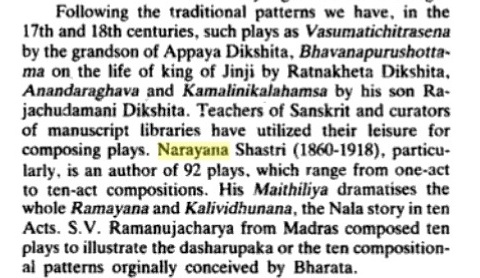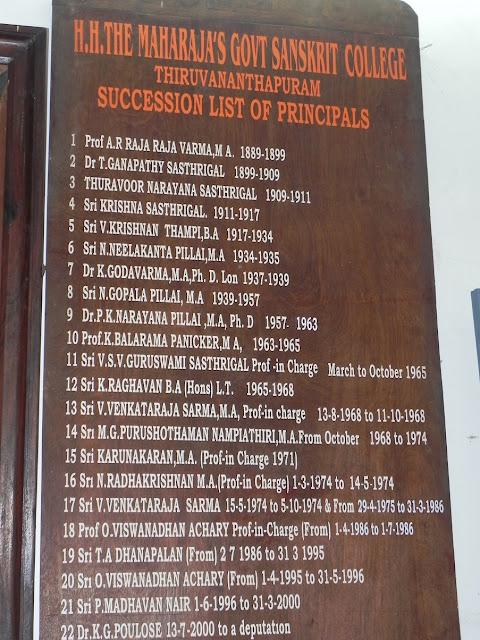Pics related to my ancestor Turavur Narayana Sastri's Sanskrit-Devanagari transcription work of Vyangyavyakhya in 1915, from K.G. Paulose's related 2013 book
Last updated on 14 Aug 2023
Copied with link update from ravisiyer.blogspot.com on 14 Apr. 2023, first published there on June 21, 2020
For background info. readers are requested to read the following previous posts:
1) My ancestor Turavur Narayana Sastri named in 21st century books & journal as 1915 Sanskrit transcriber of ancient Tapatisamvarana-dhvani & Subhadradhananjaya-dhvani (Vyangyavyakhya) Kerala drama commentaries related to Kutiyattam, https://tnarayanasasthri.blogspot.com/2023/04/my-ancestor-turavur-narayana-sastri.html , 23rd May 2020
2) Expression of gratitude to Dr. K.G. Paulose for mentioning in his 2013 Vyangyavyakhya book, my family ancestor Thuravoor (Turavur) Narayana Sastrigal as eminent traditional (Sanskrit) scholar and transcriber of Vyangyavyakhya in 1915, https://tnarayanasasthri.blogspot.com/2023/04/expression-of-gratitude-to-dr-kg.html .
---
A few weeks ago, I received a printed copy of K.G. Paulose's related book titled "Vyaṅgyavyākhyā: The Aesthetics of Dhvani in Theatre", published by Rashtriya Sanskrit Sansthan and D.K. Printworld in 2013, https://books.google.co.in/books?id=LzCNzSTekCEC, https://www.amazon.in/Vyangyavyakhya-Aesthetics-K-G-Paulose/dp/8124606994. I had ordered the book on amazon.in.
Given below are a few pics of this book which are related to Turavur (Thuravoor) Narayana Sastri (TNS) and his Sanskrit-Devanagari transcription related work. Note that TNS is my great-grandfather.
[To open pic in larger resolution, right-click on pic followed by open link (NOT image) in new tab/window. In new tab/window you may have to click on pic to zoom in.]
The reference to TNS comes in beginning of Part II, "Performance Text" of the book, with sub-title "Vyangyavyakhya" "1 Dhananjayadhvani" (Page 65).
Page 66 and 67 introduces this part, giving pics of the early Malayalam script palm leaves for the Dhananjayadhvani part of Vyangyavyakhya. Note that Dhananjayadhvani seems to be a short form of Subhadradhananjayadhvani.
In these pages, SD refers to Subhadradhananjaya (drama) and TS seems to refer to Tapatisamvaranam (drama).
It is in page 67 that we have the reference to TNS. The related sentences are: "The only Ms available to us of these text is the one owned by Kailasapurathu Govinda Pisharoti in the palace library (No. 67) in Thiruvananthapuram. This palm-leaf Ms, in early Malayalam script is very old and is worn-out in many places. Turavur Narayana Sastri, an eminent traditional scholar of the last century transcribed this in paper in Devanāgari script for the Oriental Manuscript Library Thiruvanantapuram in 1915 CE (ME 1090)."
I have given below pics of pages 66 and 67, along with additional pics of only the palm leaf manuscript pics on these pages (with higher resolution than the full page pics).
Above pic: Only palm leaf manuscript pics part of page 66
Above pic: Only palm leaf manuscript pics part of page 67
These pics give us good background on the work done by TNS in this context. The palm leaf manuscript (perhaps a few centuries old in 1915) had Sanskrit language text written in early Malayalam script. TNS read this and wrote (same, one presumes) Sanskrit language text but in Devanagari script on paper in 1915. Note that TNS had retired from Maharaja's Sanskrit college Trivandrum in 1911 as principal and, as per Kēraḷasāhityacaritraṃ, Volume 5, Uḷḷūr Es Paramēśvarayyar (see https://tnarayanasasthri.blogspot.com/2023/04/results-of-google-books-search-for.html ), continued to teach Sanskrit to students at his home in Trivandrum (near Padmanabhaswamy temple, I believe). Perhaps out of his love for Sanskrit, TNS may have taken up this task of transcribing the early Malayalam script Sanskrit language palm leaf manuscript text into handwritten Devanagari script Sanskrit language on paper (in 1915), thereby making a vital contribution to enhancing longevity for these ancient text(s). [Dr. K.G. Paulose dates original composition of these texts, referred to as Vyangyavyakhya (VV) by him, as "ninth century CE" - see page viii, in above mentioned Vyangyavyakhya book. Also page 66, whose pic is given above, has Dr. Paulose stating, "Walking in time, now we knock at the doors of the last century of the first millennium, the golden age of the Ceras. As explained, the Natyasastra - scholar recorded the performance text for the two dramas as desired by the royal dramatist, ...". In other words, Dr. Paulose states that these ancient texts were composed by the Natyasastra - scholar in the 9th century - last century of first millennium.]
Page 68 shows us the first page of the Devanagari Sanskrit text transcribed by TNS. I presume that he may have written the Devangari script Sanskrit text himself on paper. If so, then we get to see the superb Devanagari script handwriting of TNS in page 68 of the book. Pic below is of page 68.
These pics give us good background on the work done by TNS in this context. The palm leaf manuscript (perhaps a few centuries old in 1915) had Sanskrit language text written in early Malayalam script. TNS read this and wrote (same, one presumes) Sanskrit language text but in Devanagari script on paper in 1915. Note that TNS had retired from Maharaja's Sanskrit college Trivandrum in 1911 as principal and, as per Kēraḷasāhityacaritraṃ, Volume 5, Uḷḷūr Es Paramēśvarayyar (see https://tnarayanasasthri.blogspot.com/2023/04/results-of-google-books-search-for.html ), continued to teach Sanskrit to students at his home in Trivandrum (near Padmanabhaswamy temple, I believe). Perhaps out of his love for Sanskrit, TNS may have taken up this task of transcribing the early Malayalam script Sanskrit language palm leaf manuscript text into handwritten Devanagari script Sanskrit language on paper (in 1915), thereby making a vital contribution to enhancing longevity for these ancient text(s). [Dr. K.G. Paulose dates original composition of these texts, referred to as Vyangyavyakhya (VV) by him, as "ninth century CE" - see page viii, in above mentioned Vyangyavyakhya book. Also page 66, whose pic is given above, has Dr. Paulose stating, "Walking in time, now we knock at the doors of the last century of the first millennium, the golden age of the Ceras. As explained, the Natyasastra - scholar recorded the performance text for the two dramas as desired by the royal dramatist, ...". In other words, Dr. Paulose states that these ancient texts were composed by the Natyasastra - scholar in the 9th century - last century of first millennium.]
Page 68 shows us the first page of the Devanagari Sanskrit text transcribed by TNS. I presume that he may have written the Devangari script Sanskrit text himself on paper. If so, then we get to see the superb Devanagari script handwriting of TNS in page 68 of the book. Pic below is of page 68.
Page 70 has printed Devanagari text of remaining lines of manuscript shown on page 68 as well as other lines which seem to be from later part of the manuscript and page 71 has the English translation of it. First 6 Devanagari script lines (excluding verse title) of Page 70 are of remaining lines of manuscript part shown in page 68.
First 11 English translation lines (excluding verse title) of Page 71 seem to correspond to first 6 Devanagari script lines (excluding verse title) of Page 70, which are of remaining lines of manuscript part shown in page 68.
Above pic: Page 71
Pages 70 and 71 are followed by further similar pages. There are no more pics of the paper handwritten Devanagari text transcribed by TNS (like in page 68 above).
Index page 542 has this entry, "Narayana Sastri, Turavur 67". So it seems that there is only one mention of TNS in the book (on page 67 given earlier in this post).
[I thank publishers and author (Dr. K.G. Paulose) of Vyangyavyakhya book mentioned in this post, and have presumed that they will not have any objections to me sharing few pics of their book related to my great-grandfather Turavur (Thuravoor) Narayana Sastrigal, on this post which is freely viewable by all, and does not have any financial profit motive whatsoever.]












Comments
Post a Comment